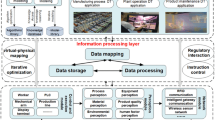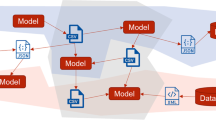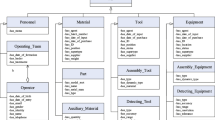Abstract
In recent years, the new generation of information technology has been widely applied in manufacturing domain. Building intelligent workshop and achieving intelligent manufacturing have become the purposes of industry development. The current workshop service systems just fulfill the mapping between physical and digital layer, while have not completed the interconnection and interaction between physical world and information world. It is the emergence of digital twin that become one of the solution to this bottleneck. In this paper, a system framework of digital twin workshop is proposed. In the light of the framework, a model of digital twin workshop based on physical perception data is established. This model is divided into three parts, which including workshop physical model, digital model based on ontology, and virtual model. Moreover, the operation mechanism of digital twin workshop is described among the three models. Finally, a three-dimensional model for a production line is built, and the connection between digital and virtual layer is established and demonstrated.
Access provided by CONRICYT-eBooks. Download conference paper PDF
Similar content being viewed by others
Keywords
1 Introduction
As the important pillar industry of our country, the workshop manufacturing promotes the development of the national economy and society. However with the much more fierce global competition and the increasing social demand, the workshop manufacturing encounters enormous pressure, including the complicated assembly technology and the fast-speed upgrading. In addition, the requirement of operators’ professional level is rising constantly. During manufacturing, it is significant to facilitate the sustainable development of enterprises, in view of the relationship among economic, environment and the social.
In the past, the collection and processing of multiple data in workshop production mainly relied on manual management. The transmission and storage of information had low real-time performance and bad efficiency according to the paper medium. Meanwhile, the material configuration, production schedule and the process monitoring were depended on human experience and feeling, with low accuracy. With the transformation of the pattern of economic development and the adjustment of industrial structure, the connection between the manufacturing and information industry is more and more closely. The emergence of information technology has greatly increased the production level of workshop, making it possible to collect data in time, draw up plans dynamically, and monitor status automatically. However the data between workshop physical space and information space lack interaction and interoperability, far from implementing fully intelligence.
Digital twin, as one of the approaches to achieving the interconnection between physical world and digital world, has attracted broad attention [1]. Digital twin not only refers to product digitization, but also incorporates the digitization of factory itself, technical process and equipment [2]. It can help enterprises to simulate and test before putting into production, as well as synchronous optimize the whole process, so as to find how running conditions affect performance, improving the productivity [3].
The digital twin workshop was studied in this paper. Section 2 introduced current researches about the digital twin and the workshop modeling. The system framework of digital twin workshop was posed in Sect. 3. In addition, the digital twin workshop model based on physical data was established and described in detail as well. Section 4 gave a simulation using Flexsim. Finally, the conclusion and outlook were drawn in Sect. 5.
2 Related Works
Digital Twin was first introduced at a presentation about Product Lifecycle Management in a University of Michigan in 2002 [4]. Afterwards, the concept of digital twin has been applied in some fields. The U.S. defense department utilized Digital Twin for the maintenance and security guarantee of the aerospace vehicle [5]. And digital twin specimens were modeled and simulated in Abaqus/Explicit, to resolve crack path ambiguity in the SFC geometry [6]. By using Digital Twin, it integrated realistic simulation and vehicle management system with abundant data together to enable safety and reliability [7]. In addition, a way was proposed to the industrial IOT life cycle management and optimization through the Digital Twin [8]. Besides, Siemens hammered at integrate manufacturing process system in information space, achieving the digitization of the whole process from product design to execution [9].
Serviceability, intelligence and sustainable had become the development trend of manufacturing workshop [10]. It is very important for manufacturing system to interact between realistic model of current process status and real environment [11]. Digital twin is one of the best ways to achieve the communication and interaction between physical space and information space [2]. Based on the digital twin technology, the concept of digital twin workshop was proposed and it was composed of physical workshop, cyber workshop, and workshop service system and workshop digital twin data [1].
A Digital Twin model included three parts including real physical entity, virtual model and process information as a bond linking real and virtual world [2]. In physical modeling respect, the allocation of resources in manufacturing execution system was introduced, and the description model of the shop manufacturing task and equipment resources was analyzed [12]. A multidimensional information model of manufacturing capability was put forward, furthermore, a description language framework was proposed too [13]. In digital modeling respect, a shared concept can be described definitely and normally by building an ontology model [14]. An ontology model of manufacturing equipment capability was promoted, what’s more, a mapping relationship between the attributes and real-time data was established [15].
In this paper, a system framework of digital twin workshop was posed. In addition, a digital twin workshop model based on physical data was established and described in detail as well. Finally, a simulation was given using Flexsim.
3 Modeling of Digital Twin Workshop Based on Perception Data
3.1 System Framework of Digital Twin Workshop
Digital twin, as an effective way to realize the communication and interaction between physical and information world, received extensive concern recently. The features are as follows. Firstly, it is the completely mapping of the physical system. Secondly, this conceptual model is dynamic and existing throughout the lifecycle of the system. Thirdly, it can visualize and simulate complex systems, optimizing the physical system constantly.
Applying the digital twin technology to workshop manufacturing may be a good approach to improving the intelligence, foreseeability and initiative of the plant. The digital twin workshop is a new operational mode. It can meet the demand of the development of intelligent manufacturing, through the integration and fusion of status data, model data, instruction data, and through the two-way real mapping and iterative optimization between physical plant, digital plant and 3D virtual plant. The system framework is shown as Fig. 1.
3.2 Modeling of Digital Twin Workshop Based on Perception Data
A model of digital twin workshop is established based on the framework proposed above. The model is composed of three modules, including plant physical model, digital model and 3D virtual model. The operation of system model relies on the interaction and iterative optimization among those three modules. And the three modules link together throughout the full life cycle, achieving the two-way mapping and interoperability by data interaction. The model is shown as Fig. 2.
The Physical Information Model of Workshop.
The plant is a complex, varied and dynamic production environment. In a narrow sense, manufacturing workshop is a physical production space which is made up of five elements including material, people, equipment, environment, and knowledge. In a broad sense, it is a production system where the staff utilizes existing or outsourcing materials, realizing production tasks by physical production unit and processing the raw materials or semi-finished products into the finished products.
According to the discussion above, the workshop physical elements are summarized. Meanwhile, the physical data in workshop is redundant and abundant, as shown in Fig. 3, which can be analyzed from resources, tasks and process dimensions.
According to the analysis of the manufacturing resources and the physical data in workshop, a physical information model for manufacturing workshop was established as shown in Fig. 4.
On the physical workshop side, the multi-sourced heterogeneous data is collected and transmitted by intelligent sensor and communication equipment, including element attribute, status, technological process, perturbation and so on. Those data will be incorporated into the digital plant and virtual plant through the transmission network. In addition, relevant physical elements will make timely and correctly response, in the light of instructions from digital plant and adjustment from virtual plant. It is very important to establish a mapping relation between attributes and real-time data, which is divided into direct mapping and indirect mapping. The connection between sensory data and model property makes it possible to realize the interaction between the workshop physical model and the digital model.
The Digital Model of Workshop Based on Multi-dimensional Ontology.
Ontology is the formal specification of conceptual models. We utilized ontology to depict the model which was established above. The formal description of workshop is as follow. The ontology of workshop manufacturing system includes resource information ontology, task information ontology and process information ontology.
The following definition describes the resource information of the workshop, which can be divided into general properties and extended properties in order to meet the demand of different resources. And they all are subclasses of ResourceInformation.
The formal description of manufacturing task ontology is as follow, which is about the information of manufacturing task.
The formal description of manufacturing process is as follow, which mainly describes dynamic parameters of workshop production. Each class has its own subclasses, such as ManufacturingProcess, which has subclasses including scheduling, technological process, equipment status, etc.
On the digital workshop side, the manufacturing service system should be established for the knowledge description, data management, state evaluation, generation of plan and instructions, etc. Meanwhile, the ontology model built above can be stored in database using Jena, so as to be easily obtained when analyzing production status or building workshop virtual model. The production plan is based on digital twin data, and simulated constantly to iterative optimization in the virtual plant. Besides, the instructions will be sent to the physical plant to process production.
The Three-dimensional Virtual Model of Workshop.
A three-dimensional virtual model of workshop is required and the connection should be established for the interaction and communication between physical and virtual model. The three-dimensional model can be built via Flexsim, which can not only simulate but also optimize the production system with the abundant modeling units in 3D virtual reality environment. Then, the attributes of virtual model can be obtained from database. Meanwhile the feedback also can be deposit in database on account of the ODBC interface. Thus the linkage between physical and virtual model of workshop is created.
On the virtual workshop side, the virtual plant, as the real mapping to the physical one, can not only visualize products, but also simulate complex systems. When conflicts and perturbations occur in physical plant, the virtual model can test timely and feedback regulations to the real production line synchronously.
4 Case Study and Analysis
The model of digital twin workshop is composed of physical, digital and virtual model. And the perception data drives the operation of system. In the process of the modeling of digital twin workshop, after the collection of multi-source heterogeneous data from intelligent manufacturing environment, it is significant to give a knowledge description using ontology. In this paper, Protégé, a general ontology editor, was used to realize the ontology structure. Figure 5 shows the ontology of workshop manufacturing system. And the workshop can be defined as a class which possesses resource information, task information and process information. The ontology of manufacturing resource is shown in Fig. 6. Besides, the Figs. 7 and 8 show the manufacturing task ontology and the manufacturing process ontology.
For the connection between digital and virtual model, a 3D workshop model was established. Figure 9 gives a virtual model specimen of production line built by Flexsim. The parts and pallets enter into the system from two different sources, and the parts loop through the processor, synthesizer and robots to complete different operations. And the Fig. 10 shows the basic status information in the manufacturing process.
The interaction between the physical and virtual plant mainly relies on the database connection. There are three steps:
-
(1)
A database named workshop data was built in MySQL, and several tables were created for saving the information of physical and virtual models.
-
(2)
A data source was established in windows system, which possessed the MySQL ODBC Driver.
-
(3)
Open the connection and load the physical information into the virtual model, which was saved in table processtimes before, as shown in Fig. 11(a). Then close the connection. Figure 11(b) gives some codes.
Taking the process time as an example, the process time of each machine was read from database. Running the virtual model for a period of time, parts of model data would be saved into database, as shown in Fig. 12, and the first column was the process time of virtual model, which was the same as the data given before. Furthermore, the information statistics of virtual model were displayed dynamically, as shown in Fig. 13, which help analyze and do the correct adjustments in time.
5 Conclusion and Future Work
In this paper, a framework of digital twin workshop has been proposed. In the light of that, the model of digital twin workshop based on physical data was established, which included physical model, digital description model based on ontology and also a simulation model built by Flexsim. And a linkage between the physical and digital model has been proposed. Finally, the simulation of a production line was realized and the linkage between the physical and virtual model was built. In the future, to realize the digital twins, a dynamic linkage among the three models should be present to make the interaction between the virtual and the real world come true, furthermore, a fully functional workshop service system and the vivid three-dimensional scenes combining with Augmented Reality technology should be considered conscientiously.
References
Tao, F., Zhang, M., Cheng, J., et al.: Digital twin workshop: a new paradigm for future workshop. Comput. Integr. Manuf. Syst. 23(1), 1–9 (2017). (in Chinese)
APRISO Digital twin: manufacturing excellence through virtual factory replication. http://www.apriso.com. Accessed 06 May 2014
Boschert, S., Rosen, R.: Digital twin—the simulation aspect. In: Hehenberger, P., Bradley, D. (eds.) Mechatronic Futures. Springer, Cham (2016)
Grieves, M., Vickers, J.: Digital twin: mitigating unpredictable, undesirable emergent behavior in complex systems. In: Kahlen, J., Flumerfelt, S., Alves, A. (eds.) Transdisciplinary Perspectives on Complex Systems. Springer, Cham (2017)
Tuegel, E., Ingraffea, A., Eason, T., et al.: Reengineering aircraft structural life prediction using a digital twin. Int. J. Aerosp. Eng. 2011, 1687–5966 (2011)
Hochhalter, J.: On the effects of modeling as-manufactured geometry: toward digital twin. Int. J. Aerosp. Eng. 2014(439278), 1–10 (2014)
Glaessgen, E., Stargel, D.: The digital twin paradigm for future NASA and U.S. air force vehicles. In: Proceedings of the 53rd Structures Dynamics and Materials Congerence, pp. 1–14. AIAA, Reston (2012)
Canedo, A.: Industrial IoT lifecycle via digital twins. In: 11th Ieee/acm/ifip International Conference on Hardware/Software Codesign and System Synthesis, p. 29. IEEE, Pittsburgh (2016)
SIEMENS The digital twin. https://www.siemens.com/customer-magazine/en/home/indus-try/digitalization-in-machine-building/the-digital-twin.html. Accessed 17 Nov 2015
Rosen, R., Wichert, G., Lo, G., et al.: About the importance of autonomy and digital twins for the future of manufacturing. IFAC-PapersOnLine 48(3), 567–572 (2015)
Schluse, M., Rossmann, J.: From simulation to experimentable digital twins: simulation-based development and operation of complex technical systems. In: IEEE International Symposium on Systems Engineering, pp. 1–6. IEEE, Edinburgh (2016)
Du, L., Fang, Y., He, Y.: Manufacturing resource optimization deployment for manufactuing execution system. In: Second International Symposium on Intelligent Information Technology Application, pp. 234–238. IEEE, Shanghai (2008)
Luo, Y., Lin, Z., Fei, T., et al.: Key technologies of manufacturing capability modeling in cloud manufacturing mode. Comput. Integr. Manuf. Syst. 18(7), 1357–1367 (2012)
Studer, R., Benjamins, V., Fensel, D.: Knowledge engineering: principles and methods. Data Knowl. Eng. 25(1–2), 161–197 (1998)
Xu, W., Yu, J., Zhou, Z., et al.: Dynamic modeling of manufacturing equipment capability using condition Information in cloud manufacturing. J. Manuf. Sci. Eng. 137(4), 1–14 (2015)
Acknowledgment
This research is supported by National Natural Science Foundation of China (Grant Nos. 51305319 and 51475343), the International Science & Technology Cooperation Program, Hubei Technological Innovation Special Fund (Grant No. 2016AHB005), and the Fundamental Research Funds for the Central Universities (Grant No. 2017III5XZ).
Author information
Authors and Affiliations
Corresponding author
Editor information
Editors and Affiliations
Rights and permissions
Copyright information
© 2017 Springer International Publishing AG
About this paper
Cite this paper
Zhang, Q., Zhang, X., Xu, W., Liu, A., Zhou, Z., Pham, D.T. (2017). Modeling of Digital Twin Workshop Based on Perception Data. In: Huang, Y., Wu, H., Liu, H., Yin, Z. (eds) Intelligent Robotics and Applications. ICIRA 2017. Lecture Notes in Computer Science(), vol 10464. Springer, Cham. https://doi.org/10.1007/978-3-319-65298-6_1
Download citation
DOI: https://doi.org/10.1007/978-3-319-65298-6_1
Published:
Publisher Name: Springer, Cham
Print ISBN: 978-3-319-65297-9
Online ISBN: 978-3-319-65298-6
eBook Packages: Computer ScienceComputer Science (R0)

















